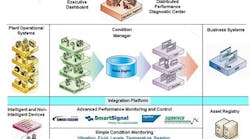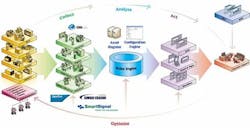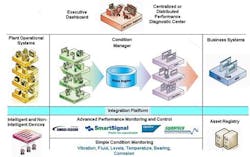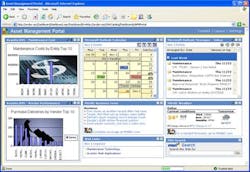In today’s environment, chemicals makers face ongoing pressure to operate safely and reliably at the lowest possible cost. Most companies have adopted condition monitoring technologies as a key approach to improve the availability and reliability of process equipment and to proactively avoid downtime.
While these condition monitoring solutions are providing solid value for most plants, unplanned outages continue to be an issue, significantly impacting financial performance through lost production and extra repair costs.
So, in this article, we’ll explore the underlying challenges and introduce the concept of condition management — an enhanced approach that helps companies reap the full benefit from their condition monitoring investments. We’ll also discuss how to get started in condition management, looking at both business and technical considerations.
Building upon a baseline
For years plants have tracked the health of key equipment. Sites generally have focused on a relatively limited deployment of specific monitoring technologies aimed at protecting critical assets — primarily large rotating equipment. This has become simpler with the widespread availability of highly capable fieldbus-enabled monitoring tools, e.g., for vibration, temperature, pressure, corrosion and fluid analysis.
Now, the advent of intelligent field devices and sensors as well as low-cost wireless units that can be deployed into areas where hard wiring would have been cost-prohibitive is extending these base capabilities and the data they provide.
Unfortunately, plants aren’t enjoying the full potential of the data for three reasons:
- The focus of condition monitoring deployments is too narrow. Sites need to instrument a wider range of assets, so management can look beyond specific equipment to entire process areas or complex asset sets such as heat exchangers, dryers and other plant units.
- The volume of data available now is huge and will continue to grow exponentially. This creates a significant knowledge management challenge around making sense of the data. Exacerbating the problem, the aging workforce means that plants are losing more and more people with critical operational experience, knowledge and interpretive skills.
- Many companies still have operational silos. Plant personnel aren’t collaborating to detect, manage and analyze emerging issues. The net result is continued outages, even when the underlying condition or trend had been correctly detected.
Condition management defined
Addressing this set of challenges requires an enhanced, more holistic approach — condition management. Under this approach, the vast array of condition data is the entry point to a five-step process where the data are:
- aggregated and rationalized;
- combined to create context and support proper analysis;
- clearly presented and communicated;
- systematically managed to ensure the timely, accurate, consistent and effective resolution of the underlying issues; and
- used as input to an ongoing continuous improvement process.
The first three elements are aimed at turning the data into information, changing the condition information from “noise” in the eyes of operations personnel into useful decision support intelligence for all personnel.
The aggregation and rationalization also need to address the varying types of data, the time element (real-time, near-time and offline) as well as the various access and communication methods utilized by vendors.
Once the data are turned into properly contextualized and actionable information, it’s critical to manage the use of the information. It comes back to the fundamental difference between condition monitoring and condition management. Condition management information helps unlock the usefulness of the condition data by:
- driving the appropriate workflow/processes to resolve the issue(s), bringing together the key personnel across operational disciplines (engineering, maintenance, control, safety, etc.).
- providing input to an ongoing knowledge management process where new situations and their appropriate resolution are systematically captured and documented.
Further, condition management supports Six Sigma or Lean Sigma initiatives by supplying input for an ongoing process where the knowledge base is regularly reviewed and refined.
A telling example
A leading specialty chemicals maker discovered the value of the approach but only after a serious incident. The process uses a significant amount of power, so the company operates a 300-MW captive power plant. The site had deployed condition monitoring tools on assets there — vibration, rpm, and amperage on the pumps in the cooling towers, the manufacturer’s monitoring tools on the turbine, and assorted flow and temperature meters throughout the cooling system.
When the primary pump in the cooling tower failed, the control system initiated a cutover to a back-up pump and then cleared the alarm. An operator entered the occurrence in the log, where the required follow-up was to have maintenance staff repair the primary pump.
Shortly after this initial incident, the operator started receiving alarms that the temperatures in the cooling system were drifting out of range, coupled with pressure warnings. Assuming that this was a “storm” created by the cutover to the back-up pump, the operator acknowledged and cleared the alarm set.
Close on the heels of this second set of indications, the turbine monitoring system flagged a significant temperature variance and recommended an immediate shutdown. Again, on the assumption that this was a blip caused by the cutover, the operator cleared the alarm.
After two minutes, which was the defined “re-alarm” time, the turbine monitoring system reported dangerously high temperatures and again recommended a shutdown. This time, the operator (per the written procedures) contacted the plant manager, who gave approval to proceed with the shutdown.
This caused a production outage that impacted delivery of a critical intermediate to one of the company’s key customers. Further, the sequence of events and the elapsed time from initial warnings to shutdown resulted in extreme temperatures within the turbine. This led to significant damage, necessitating the replacement of its main bearings.
The root cause turned out to be that back-up pump had not come online as expected. In doing the situation analysis, the company discovered a number of specific issues:
- The back-up pump wasn’t instrumented in the same manner as the primary one, so there wasn’t any critical warning to the operator.
- Condition information for the primary pump and the back-up pump weren’t linked.
- The pump, temperature/pressure and turbine data weren’t connected. Each was handled discretely by the operator in separate areas of the human/machine interface (HMI); the combined elapsed time in dealing with the discrete events exceeded the safe shutdown point for the turbine.
- No automated communication alerted maintenance, engineering or plant management to the developing issue.
- The operator didn’t have any way of seeing the maintenance status of the primary assets including the pumps — this would have shown that the back-up pump had a pending inspection because of previously reported issues.
Looking at this real-life example in its entirety, no particular action or practice alone could be blamed. Instead, the situation arose because of the lack of context and ineffective use (i.e., management) of available information.
The foundation for success
As the example underlines, effective condition management must address all of the elements together. Specifically this means:
- collecting the right data (condition, process area and system);
- gathering the complete set of data necessary to provide the context needed to accurately assess an issue and its impact;
- automating the response, including actions and escalations; and
- enforcing the post-event analysis and continuous improvement process.
Moving to condition management is ultimately a knowledge management challenge. In many companies, such a move requires a change in both technical and business process practices. This challenge is manageable but firms need to be committed to the change in approach and need the discipline to effectively implement and sustain it.
The process has to include the use of supporting tools and technologies that allow the capture of the institutional knowledge currently existing in plant personnel across all the disciplines.
Figure 1. Success depends upon properly using wide variety of inputs from all plant levels. (Click image to enlarge).
Condition management fundamentally is a closed-loop model with four main elements — collect, analyze, act and optimize. This model provides the framework for translating the business needs into a solution architecture for a plant. Figure 1 shows the relationships among these elements, starting at the process measurement level through decision support and feeding back to the process.
Getting started
As with any change process, it’s critical to understand the starting point. This demands taking a hard look at several areas and asking some tough questions:
Culture. Does the company understand that there are issues and that there’s inherent and significant value in resolving them? As a simple test, can people articulate the impact or cost of an unplanned outage? Is the company really willing and ready to change? Effective condition management will include changes to business processes and roles, so these points are fundamental.
Business processes. Are the firm’s processes documented? Have they recently been validated or benchmarked against others in the industry and best practices? In many cases, simple process enhancements or better communication can deliver significant performance improvements. Don’t apply technology without this process baseline. Note in particular that a formal approach based on root-cause analysis and including continuous improvement efforts is a fundamental requirement.
At a broader level check whether a formal lifecycle management program is in place. A recent survey conducted by the ARC Advisory Group found that companies that had adopted such a program had a significantly better return on assets than those that hadn’t. The research also indicated that the largest portion of the gains come from properly managing the “operate and maintain” stages of the lifecycle. It’s precisely here where condition management is a key enabler of improvements. The ARC lifecycle model, (Figure 2) shows the relationship between plant asset management (PAM) and an asset lifecycle management scheme.
Figure 2. In CALM, the operate/maintain stage offers the largest portion of return-on-asset improvement. Source: ARC
{pb}
Corporate knowledge. Does the company have a knowledge management process or tools? What’s the current state of the work force? Is a retirement bubble coming up that necessitates immediate action? Does the company really know where the necessary knowledge resides?
Skill base. Does the firm have the essential expertise in areas such as reliability-centered or condition-based maintenance, optimization, advanced process control (APC), and condition monitoring and analysis?
Technology base. To fully achieve the promise of condition management, a wide range of technologies both in the plant and at the corporate level need to come together (Figure 3).
Figure 3. Plant- and corporate-level technologies need to come together effectively. (Click to enlarge).
So, engineers, planners and managers need to work together and ask themselves a series of technology questions that focus on five key areas.
- The state of the core automation systems. Is the distributed control system current? Is the plant using a digital fieldbus with intelligent devices, traditional 4–20-mA analog or both? This will impact what data are available and how to access them.
It’s important to understand that the plant doesn’t need to be “state of the art.” Many new analytic tools can infer conditions from the simple data points that are being collected as part of the control strategy.
It’s also crucial not to confuse alarm management with condition management. Alarm management plays a critical role in dealing with the huge number of discrete input/output points that are part of the control strategy, working in real time at a discrete level. Condition management complements alarm management by performing the advanced analytics that warn of a developing issue long before it becomes a process or system alarm or alarm storm. - The current level of condition monitoring. What instrumentation is in place? Which assets are addressed? What data can these current tools provide? How are the data currently used? What tools are being used? What processes are in place to deal with the issues identified? Is there any automation of these processes?
Find out if the information already being gathered is handled in systematic or automated fashion and moves across departmental boundaries. One of the major values of condition management is making information useful beyond the realm of the collection point or device — putting it in a broader context. - The current level of APC and process optimization. Is the company using such solutions? These models can play a key role in identifying and understanding the dependencies and context for the condition data.
- Integration infrastructure. Does the firm have a standardized way for integrating applications at the plant level, applications at the business level and among plant and business applications? This will be critical for gathering the condition information at the plant level and then driving the workflow necessary to resolve issues. For example, if a critical condition is recognized, automated workflow tools should page or email the key personnel, automatically trigger the necessary work requests or work orders to the maintenance team and update the necessary HMIs and management dashboards.
- Business intelligence. Is there an integrated measurement system as well as a vehicle to deliver the information across the company? The vehicle most commonly employed is some form of portal or dashboard solution such as the one shown in Figure 4.
Figure 4. Such a graphical display often serves as the vehicle for delivering information. (Click to enlarge).
The next steps
The analysis that establishes the foundation or starting point is the most important step in the path to condition management. It is a comprehensive effort that brings information and, importantly, people, together. It also provides the groundwork for setting priorities and expectations and for understanding the implications on processes and roles.
With the foundation effort complete, a company can better see the possibilities for value and improvement, determine risk/reward and identify which parts of condition management can be implemented first. The success of initial low-risk/high-reward projects, in turn, can fund an ongoing program.
Many chemical makers can gather the information for a condition management baseline from within. This valuable effort can enable them to more clearly understand their resources, processes, limitations and options.
However, the subsequent steps can be complex and likely will involve the assistance of a technology partner familiar with the tools and solutions required for a condition management architecture, not just condition monitoring.
Condition management is an over-arching solution that makes use of the mountains of data generated by individual condition monitoring systems. It combines, rationalizes, presents and communicates decision support information effectively. It truly can help management identify the actions and practices needed to get full benefit from monitoring investments and, in turn, optimize the return from plant asset investments.
Neil Cooper is vice president of asset performance management solutions for Invensys Process Systems, Burlington, Ont. E-mail him at [email protected].






